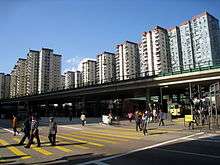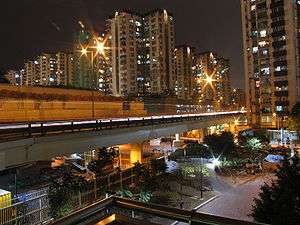Mei Foo Sun Chuen
Mei Foo Sun Chuen or simply Mei Foo is a large private housing estate in Lai Chi Kok, Kowloon, Hong Kong. Mei Foo Sun Chuen was the first large scale private housing estate in Hong Kong and at the time of completion, the 99 tower complex was considered the largest private housing development in the world,[1] accommodating some 70,000 – 80,000 people in 13,500 apartments.[1] It is considered to be one of the world's largest privately financed residential condominium projects.[1]
| Mei Foo Sun Chuen | |||||||||||||
|---|---|---|---|---|---|---|---|---|---|---|---|---|---|
 Regular blocks of Mei Foo Sun Chuen | |||||||||||||
| Chinese | 美孚新邨 | ||||||||||||
| Literal meaning | Mobil New Estate | ||||||||||||
| |||||||||||||

History
The 40-acre Mei Foo Sun Chuen, with a total of ninety-nine blocks, was completed from 1968 to 1978 in eight separate but interconnected stages.[1] It is located on the reclamation that had been a large petroleum-storage facility of Mobil (now part of ExxonMobil) in Hong Kong (Mobil's Chinese trading name in Hong Kong is 美孚; Mei Foo) from the 1920s. The redevelopment was carried out by Mei Foo Investments Limited, a subsidiary company of Mobil Oil (Hong Kong) Limited.[1]
Mei Foo Sun Chuen was conceived to meet the housing needs of Hong Kong's middle-income families, an emerging and growing group at the time.[1] At the time, a flat in Mei Foo cost around HK$40,000.
Buildings
The residential complexes of Mei Foo were considered very affluent for the standards at the time they were built; every flat offers a balcony, at least two rooms and one bathroom. The apartment sizes vary from 600 to 1,800 square feet (56 to 167 square metres). Every apartment complex has a 24-hour uniformed, unarmed security force. Entry to a residential block requires an entrance code, which changes periodically.
Mei Foo Sun Chuen has several schools, medical clinics, beauty salons, newspaper kiosks, supermarkets, shopping arcades, restaurants and food markets within its vicinity, making the area very convenient for residents. The private secondary schools in particular were notable for academically poor students. However, some schools have evolved into multicultural ones.
The once largest owners' corporation with legal status in Hong Kong, the Incorporated Owners of Mei Foo Sun Chuen – Stage I, was formed in 1997. The founder of the corporation, Yiu Chi-Wai, served as the Chairman of the Management Committee from 1997 to 2000. The other seven stages' owners' corporations were also formed during the period.
Demographics
In the 2016 by-census, the population of Mei Foo Sun Chuen was recorded as 37,303. The median age of the estate's residents was 42.7.[2]
Transport
Mei Foo is on the crossroad between Kowloon and Tsuen Wan. It is also considered part of the west border of urban Kowloon. Kwai Chung Road and Lai Chi Kok Bridge are the major roads in the area. A major bus terminus is located under the Kwai Chung Road underpass. serving as a terminus for multiple bus routes. The MTR rapid transit railway services Mei Foo Station is connected to the Tsuen Wan Line, completed in 1982, and to the West Rail Line, operational since 2003. Alternate forms of public transport like minibuses and taxis also service the estate.
In 2009, the new Route 8 tunnels opened near Mei Foo, providing a much more direct road link to the eastern New Territories.
Number of routes in Mei Foo Bus Terminus : Kowloon Motor Bus Route No. 102, 2A, 6, 6C, 38A, 46X, 86, 98C
Night bus: Kowloon Motor Bus Route No. N122, N260, N269, N241 [3]
Events
- DBS Bank safe deposit box destruction incident (2 October 2004)
Gallery
A collection of photos pertaining to Mei Foo Sun Chuen is shown below:
 Mount Sterling Mall before renovation (2008)
Mount Sterling Mall before renovation (2008) Mei Foo Sun Chuen shopping arcade atrium (2010)
Mei Foo Sun Chuen shopping arcade atrium (2010)- Podium
- Waterfront




See also
- Mei Foo (MTR)
- List of buildings and structures in Hong Kong
- List of areas of Hong Kong
- Wong Tung & Partners
- Mei Foo Ferry Pier
References
- Chan, Chi-kau, Johnnie Casire, "Community development and management of private sector housing estates in Hong Kong" Archived 24 October 2013 at the Wayback Machine, University of Hong Kong, August 1995
- "Major Housing Estates". 2016 Population By-census. Census and Statistics Department.
- http://kmb.hk Archived 7 February 2014 at the Wayback Machine
External links
| Wikimedia Commons has media related to Mei Foo Sun Chuen. |
- S.K. Hui, A. Cheung, J. Pang, "A Hierarchical Bayesian Approach for Residential Property Valuation:Application to Hong Kong Housing Market", International Real Estate Review, 2010 Vol. 13 No.1: pp. 1 – 29
- Yu, Pui-kwan, Robin, "A study on quasi-public space in large scale private residential development, case in Hong Kong", University of Hong Kong, 2007